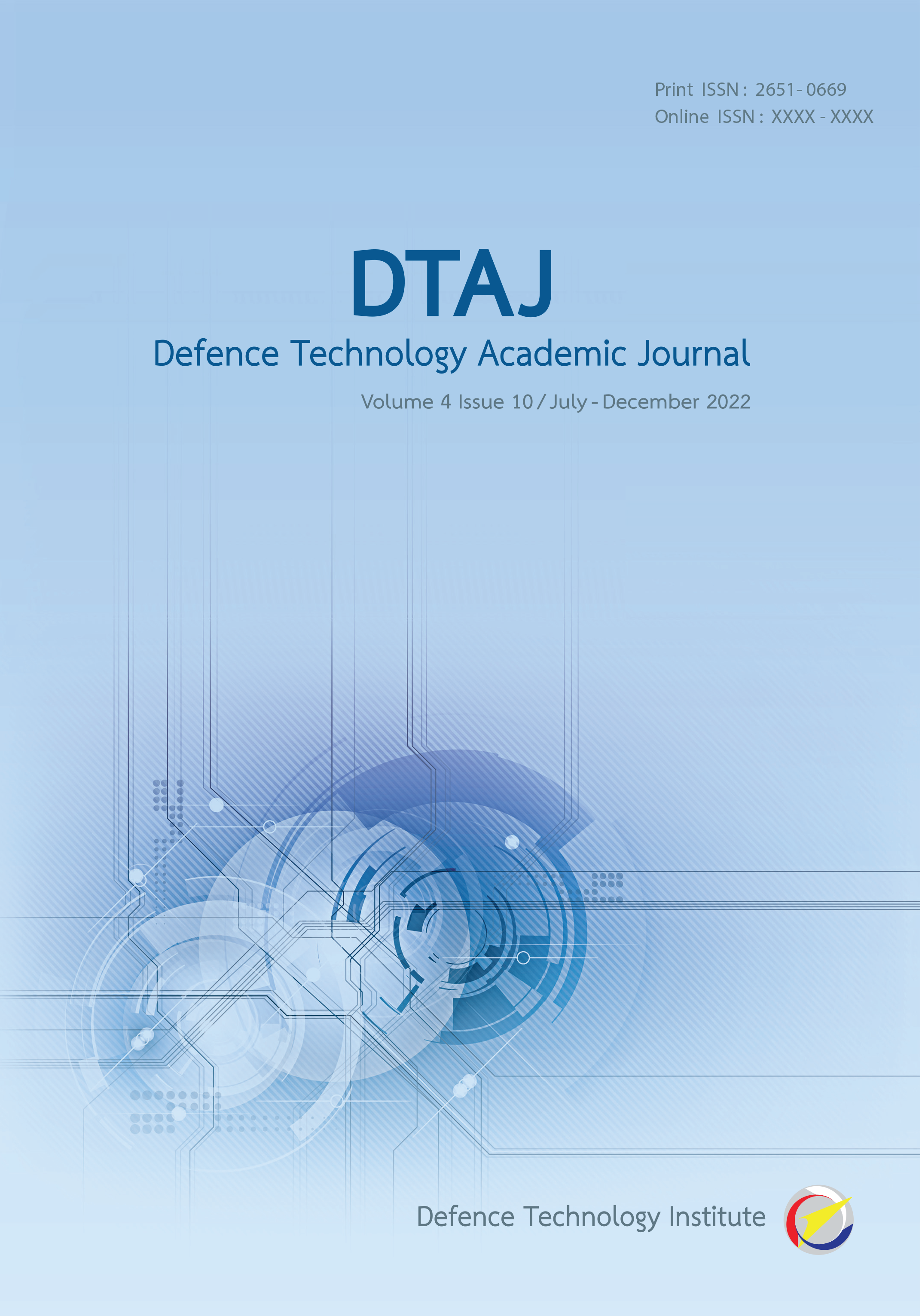การศึกษาแบบจำลองแลนเชสเตอร์สำหรับสมรภูมิทางอากาศที่ความน่าจะเป็นของการโจมตีสำเร็จขึ้นกับระยะทาง
Main Article Content
บทคัดย่อ
ในสมรภูมิยุคใหม่นั้น การจะวิเคราะห์และพยากรณ์ผลลัพธ์ของสมรภูมิด้วยความรู้และประสบการณ์ ของผู้บัญชาการในการรบเพียงอย่างเดียวเป็นเรื่องที่ซับซ้อนเกินไป ดังนั้นการมีเครื่องมือหรือแบบจำลอง เพื่อช่วยในการวิเคราะห์และพยากรณ์จึงหลีกเลี่ยงไม่ได้ จุดประสงค์ของวิจัยชิ้นนี้ คือศึกษาและพัฒนา แบบจำลองทางคณิตศาสตร์ของสมรภูมิการรบทางอากาศ โดยเริ่มต้นจากแบบจำลองแลนเชสเตอร์ แล้วจึง ดำเนินการประยุกต์เพิ่มตัวแปรเพื่อให้สามารถเก็บพฤติกรรมทั้งหมดของสมรภูมิได้ โดยสมการหลักเป็นสมการ การเปลี่ยนแปลงของการเปรียบเทียบกำลังรบของสองกองกำลัง โดยมีปัจจัยสำคัญของสมรภูมิการรบทางอากาศ เช่น การโจมตีทางอากาศ ระบบป้องกันตัวเอง ระบบเรดาร์ การรับรู้สถานการณ์ข้าศึก ระบบป้องกันภัยทางอากาศ และการเสื่อมสภาพของอากาศยานในการพร้อมรบ จะถูกนำเข้ามารวมไว้ในแบบจำลองนี้ด้วย นอกจากนี้ พฤติกรรมและผลกระทบของการเปลี่ยนแปลงอัตราความน่าจะเป็นของการยิงถูกเป้าหมายของอาวุธอากาศยาน ที่ขึ้นกับระยะทางจะถูกนำมาวิเคราะห์และศึกษาด้วย จากนั้นตัวอย่างกรณีศึกษาจะถูกนำมาวิเคราะห์และอธิบาย โดยผลของงานวิจัยชิ้นนี้จะช่วยเพิ่มความรู้ความเข้าใจเกี่ยวกับสมรภูมิทางอากาศให้ดีมากยิ่งขึ้น ซึ่งแบบจำลอง ทางคณิตศาสตร์นี้จะสามารถนำไปประยุกต์ใช้ในการเรียนการสอนและการวางแผนการรบทางอากาศ
Downloads
Article Details

อนุญาตภายใต้เงื่อนไข Creative Commons Attribution-NonCommercial-NoDerivatives 4.0 International License.
Journal of TCI is licensed under a Creative Commons Attribution-NonCommercial-NoDerivatives 4.0 International (CC BY-NC-ND 4.0) licence, unless otherwise stated. Please read our Policies page for more information...
เอกสารอ้างอิง
D. A. Novikov, “Hierarchical Models of Warfare,” Automat. Remote Control, vol. 74, no. 10, pp. 1733 - 1752, 2013.
A. M. Novikov and D. A. Novikov, “Methodology,” M.: SINTEG, 2007, p. 668.
F. W. Lanchester, Aircraft in Warfare: The Dawn of the Fourth Arm, London, Constable and Company Limited, 1916.
S. J. Deitchman, “A Lanchester Model of Guerrilla Warfare,” Oper. Res., vol. 10, no. 6, pp. 818 - 827, 1962.
G. G. Brown and A. R. Washburn, “The Fast Theater Model (FATHM),” Mil. Oper. Res., vol. 12, no. 4, pp. 33 - 45, 2007.
H. W. Jones, COSAGE User’s Manual, Volume 1-Main Report. Revision 4. ARMY CONCEPTS ANALYSIS AGENCY BETHESDA MD, 1995.
E. S. Adams and M. Mesterton-Gibbons, “Lanchester’s Attrition Models and Fights Among Social Animals,” Behav. Ecol., vol. 14, no. 5, pp. 719 - 723, 2003.
D. D. Johnson and N. J. MacKay, “Fight the Power: Lanchester’s Laws of Combat in Human Evolution,” Evol. Hum. Behav., vol. 36, no. 2, pp. 152-163, 2015.
M. A. Stanescu, N. Barriga, and M. Buro, “Using Lanchester Attrition Laws for Combat Prediction in StarCraft,” in 11th Artif. Intell. Interac. Digit. Entertainment conf., 2015.
S. Jørgensen and S. Sigué, “A Lanchester Type Dynamic Game of Advertising and Pricing,” in Games in Management Science, Springer, Cham., 2020, pp. 1 - 14.
M. Kress, “Lanchester Models for Iirregular Warfare,” Mathematics, vol. 8, no. 5, p. 737, 2020.
T. W. Lucas and T. Turkes, “Fitting Lanchester equations to the Battles of Kursk and Ardennes,” Nav. Res. Logistics, vol. 51, pp. 95 - 116, 2004.
M. Sahni and S. K. Das, “Performance of Maximum Likelihood Estimator for Fitting Lanchester Equations on Kursk Battle Data,” J. Battlef. Technol., vol. 18, no. 2, pp. 23 - 30, 2015.
N. MacKay, C. Price, and A. J. Wood, “Weight of Shell Must Tell: A Lanchestrian Reappraisal of the Battle of Jutland,” History, vol. 101, no. 4 (347), pp. 536 - 563, 2016.
P. R. Syms, “Validating Lanchester Models: The First 60 Years,” in 34th Int. Symp. Mil. Oper. Res. (ISMOR), Jul. 2017.
S. Pattanasagulloy and T. Luangwilai, “Mathematical Modelling of Air Combat by Using Lanchester Model,” The Journal of King Mongkut’s University of Technology North Bangkok, (In press).
K. Iida, Theory of Operation Research Applied for Nation Defense. Nagoya, Japan. Sankeisha, 2002.
T. Komiya, Lanchester Model, Nagoya, Japan. Sankeisha, 2019.
J. X. Liu, S. H. Xu, J. S. Gao, and Y. Q. Yuan, “An Integrated Network/firepower Operation Model Based on Lanchester Equation,” Vibroengineering PROCEDIA, vol. 17, no. 2, pp. 112 - 117, 2018.
T. Komiya and I. Koji, “Deterministic Lanchester Model of Missile Striking Battle (Part 2) Evaluation Model of Regional Air Defensecapability and Information Capability,” Scientific and engineering journal of the national defense academy, Japan, 2006.
R. E. Bach, Jr, L. Dolanský, and H. L. Stubbs, “Some Recent Contributions to the Lanchester Theory of Combat,” Oper. Res., vol. 10, no. 3, pp. 314 - 326, 1962.
S. H. Denney, A review of literature on the theory of hit and kill probabilities, 1970.
Steigers and C. William, “A Critical Analysis of a Range Dependent Probability of Kill for the NATO Seasparrow Missile System,” M.S. Thesis, Nav. Postgraduate School, Monterey, CA, USA, 1993.
G. A. Rao and S. P. Mahulikar, “New Criterion for Aircraft Susceptibility to Infrared Guided Missiles,” Aerosp. Sci. Technol., vol. 9, no. 8, pp. 701 - 712, 2005.


